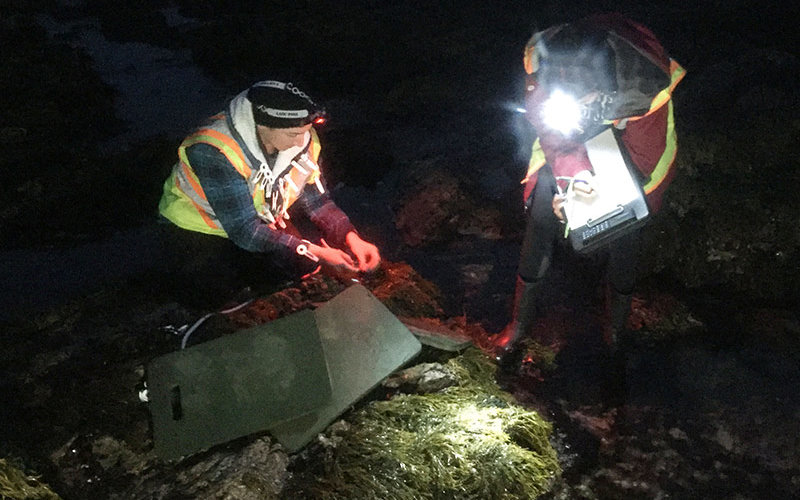
Twice a month, in the middle of the night, biology graduate student Ariel Heyman works at her research field sites along Orange County’s rocky shorelines. In the dark, between midnight and daybreak, she records data on the health of Pelvetiopsis californica, a fleshy brown alga that lives in the rocky intertidal zone.
The nighttime research is essential in efforts to obtain the best measurements of the seaweed’s photosynthetic health since it is not exposed to sunlight, Heyman explains. She also spends several days a month at her ocean research sites collecting other data.
The former high school biology and environmental science teacher became intrigued about how climate change affects ecosystems and enrolled in the university’s graduate program to find answers. She is hoping her seaweed research will shed light on how the rocky intertidal ecosystem — where land meets the ocean — fares under changing environmental conditions.
“Seaweeds are an important part of intertidal ecosystems because they provide habitat and food for marine animals,” Heyman points out.
This species of seaweed is used to spending most of the day out of the water during low tides. But with rising sea levels due to melting ice caps, this seaweed’s survival could be threatened, Heyman says.
This research will give us an idea of whether our local rocky intertidal communities have a chance of surviving climate change. — Ariel Heyman, biology graduate student
Heyman began her study last year for her graduate thesis project, under the mentorship of Jennifer Burnaford, associate professor of biological science.
“This research is important since it will allow scientists and others to plan for conservation and mitigation efforts to protect marine ecosystems,” Heyman says. “I want to find out if it this seaweed has the potential to survive under climate change conditions. I also hope that projects like mine raise awareness about the complex and far-reaching impacts of human actions that we often don’t think about.”
She has completed seaweed population surveys at four sites along the Orange County coastline to get baseline data on how this species normally lives and reproduces. Heyman also transplanted seaweeds deeper into the ocean at two sites to simulate sea level rise conditions and is recording growth, damage, reproduction and photosynthetic health.
Her project is extremely timely given the acknowledged threats of sea level rise in coastal ecosystems, Burnaford relays.
“This research is tremendously exciting because she has set up a manipulative field experiment and is taking in data to determine not only if the seaweed she is studying will survive under conditions of sea level rise, but also how new conditions will affect its health, interactions with other species in the environment and its reproduction,” Burnaford adds.
Heyman also is measuring environmental factors such as light, salinity and temperature to determine exactly how the environment experienced by seaweed in her sea level rise treatment areas differs from seaweed in their natural location, Burnaford notes.
Her research efforts have not gone unnoticed. Heyman has garnered national awards, including the best graduate poster at the National Organization of Gay and Lesbian Scientists and Technical Professionals conference held in Los Angeles last spring. In November, she won the best graduate oral presentation in the life sciences, ecology and evolutionary biology category at the Society for the Advancement of Chicanos/Hispanics and Native Americans in Science conference in Hawaii.
The student researcher plans to finish data collection in January, complete her thesis project next fall and publish her findings in a scientific journal.
“This research will give us an idea of whether our local rocky intertidal communities have a chance of surviving climate change.”